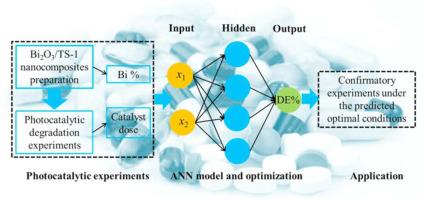Process Safety and Environmental Protection ( IF 6.9 ) Pub Date : 2021-11-23 , DOI: 10.1016/j.psep.2021.11.031 Qiaoyan Shang 1 , Wenwen Chi 1 , Pengfei Zhang 1 , Yujie Ling 1 , Xiaojuan Liu 1 , Guanwei Cui 1 , Wenge Liu 1 , Xifeng Shi 1 , Bo Tang 1

|
At present, it is a challenge to degrade antibiotics of low concentrations in wastewater environment, highly effective and eco-friendly photocatalytic processes were considered promising technologies for this degradation. In this work, Bi2O3-loaded titanium silicalite-1 molecular sieve (Bi2O3/TS-1) composites were prepared and used to degrade low-concentration erythromycin (ERM) in wastewater. The content of active components and the dose of photocatalyst are key operating parameters with major effects on photocatalytic efficiency. The optimal parameters (Bi content and photocatalyst dose) were determined through artificial neural network simulating the relationship between key operating parameters and removal efficiency (RE). The maximum RE (98.02%) was measured under optimal operating parameters (Bi % = 5.5%, catalyst dosage = 0.6 g/L). The effects of water quality parameters (such as pH and ERM concentration) were also studied under optimal experimental conditions. Artificial intelligence was used in this work to achieve optimal control of catalyst preparation and photocatalytic reaction conditions. This study provides a useful strategy for the preparation of nanocatalysts and the practical application of high-efficiency photocatalytic reactions.
中文翻译:

基于人工神经网络的低浓度红霉素废水处理Bi2O3/TS-1制备及光催化反应条件优化
目前,在废水环境中降解低浓度抗生素是一个挑战,高效和环保的光催化过程被认为是这种降解的有前途的技术。在这项工作中,负载Bi 2 O 3 的钛硅沸石-1 分子筛(Bi 2 O 3/TS-1) 复合材料被制备并用于降解废水中的低浓度红霉素 (ERM)。活性成分的含量和光催化剂的剂量是关键的操作参数,对光催化效率有重大影响。通过人工神经网络模拟关键操作参数与去除效率(RE)之间的关系,确定最佳参数(Bi含量和光催化剂剂量)。在最佳操作参数(Bi % = 5.5%,催化剂用量 = 0.6 g/L)下测量了最大 RE (98.02%)。还在最佳实验条件下研究了水质参数(如 pH 值和 ERM 浓度)的影响。在这项工作中使用人工智能来实现催化剂制备和光催化反应条件的优化控制。










































 京公网安备 11010802027423号
京公网安备 11010802027423号